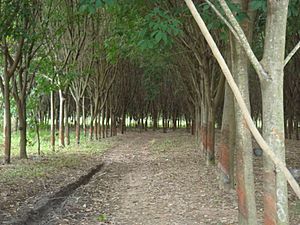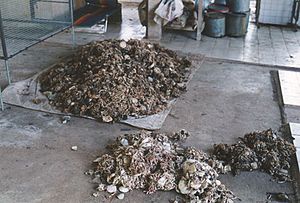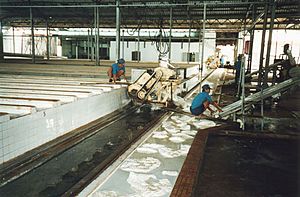Natural rubber facts for kids
Natural rubber, also called by other names of India rubber, latex, Amazonian rubber, caucho or caoutchouc, as initially produced, consists of polymers of the organic compound isoprene, with minor impurities of other organic compounds, plus water. Thailand and Indonesia are two of the leading rubber producers. Forms of polyisoprene that are used as natural rubbers are classified as elastomers.
Currently, rubber is harvested mainly in the form of the latex from the rubber tree or others. The latex is a sticky, milky colloid drawn off by making incisions in the bark and collecting the fluid in vessels in a process called "tapping". The latex then is refined into rubber that is ready for commercial processing. In major areas, latex is allowed to coagulate in the collection cup. The coagulated lumps are collected and processed into dry forms for marketing.
Natural rubber is used extensively in many applications and products, either alone or in combination with other materials. In most of its useful forms, it has a large stretch ratio and high resilience, and is extremely waterproof.
Varieties
Hevea brasiliensis
The major commercial source of natural rubber latex is the Amazonian rubber tree (Hevea brasiliensis), a member of the spurge family, Euphorbiaceae. This species is preferred because it grows well under cultivation. A properly managed tree responds to wounding by producing more latex for several years.
Congo rubber
Congo rubber, formerly a major source of rubber, came from vines in the genus Landolphia (L. kirkii, L. heudelotis, and L. owariensis).
Dandelion
Dandelion milk contains latex. The latex exhibits the same quality as the natural rubber from rubber trees. In the wild types of dandelion, latex content is low and varies greatly. In Nazi Germany, research projects tried to use dandelions as a base for rubber production, but failed. In 2013, by inhibiting one key enzyme and using modern cultivation methods and optimization techniques, scientists in the Fraunhofer Institute for Molecular Biology and Applied Ecology (IME) in Germany developed a cultivar that is suitable for commercial production of natural rubber. In collaboration with Continental Tires, IME began a pilot facility.
Properties
Rubber exhibits unique physical and chemical properties. Rubber's stress–strain behavior exhibits the Mullins effect and the Payne effect and is often modeled as hyperelastic. Rubber strain crystallizes.
Due to the presence of weakened allylic C-H bonds in each repeat unit, natural rubber is susceptible to vulcanisation as well as being sensitive to ozone cracking.
The two main solvents for rubber are turpentine and naphtha (petroleum). Because rubber does not dissolve easily, the material is finely divided by shredding prior to its immersion.
An ammonia solution can be used to prevent the coagulation of raw latex.
Rubber begins to melt at approximately 180 °C (356 °F).
Elasticity
On a microscopic scale, relaxed rubber is a disorganized cluster of erratically changing wrinkled chains. In stretched rubber, the chains are almost linear. The restoring force is due to the preponderance of wrinkled conformations over more linear ones. For the quantitative treatment see ideal chain, for more examples see entropic force.
Cooling below the glass transition temperature permits local conformational changes but a reordering is practically impossible because of the larger energy barrier for the concerted movement of longer chains. "Frozen" rubber's elasticity is low and strain results from small changes of bond lengths and angles: this caused the Challenger disaster, when the American Space Shuttle's flattened o-rings failed to relax to fill a widening gap. The glass transition is fast and reversible: the force resumes on heating.
The parallel chains of stretched rubber are susceptible to crystallization. This takes some time because turns of twisted chains have to move out of the way of the growing crystallites. Crystallization has occurred, for example, when, after days, an inflated toy balloon is found withered at a relatively large remaining volume. Where it is touched, it shrinks because the temperature of the hand is enough to melt the crystals.
Vulcanization of rubber creates di- and polysulfide bonds between chains, which limits the degrees of freedom and results in chains that tighten more quickly for a given strain, thereby increasing the elastic force constant and making the rubber harder and less extensible.
Production
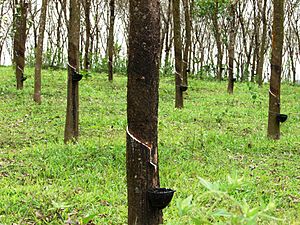
More than 28 million tons of rubber were produced in 2017, of which approximately 47% was natural. Since the bulk is synthetic, which is derived from petroleum, the price of natural rubber is determined, to a large extent, by the prevailing global price of crude oil. Asia was the main source of natural rubber, accounting for about 94% of output in 2005. The three largest producers, Thailand, Indonesia (2.4 million tons) and Malaysia, together account for around 72% of all natural rubber production. Natural rubber is not cultivated widely in its native continent of South America due to the existence of South American leaf blight, and other natural predators.
Cultivation
Rubber latex is extracted from rubber trees. The economic life period of rubber trees in plantations is around 32 years — up to 7 years of immature phase and about 25 years of productive phase.
The soil requirement is well-drained, weathered soil consisting of laterite, lateritic types, sedimentary types, nonlateritic red or alluvial soils.
The climatic conditions for optimum growth of rubber trees are:
- Rainfall of around 250 centimetres (98 in) evenly distributed without any marked dry season and with at least 100 rainy days per year
- Temperature range of about 20 to 34 °C (68 to 93 °F), with a monthly mean of 25 to 28 °C (77 to 82 °F)
- Atmospheric humidity of around 80%
- About 2000 hours sunshine per year at the rate of six hours per day throughout the year
- Absence of strong winds
Many high-yielding clones have been developed for commercial planting. These clones yield more than 2,000 kilograms per hectare (1,800 lb/acre) of dry rubber per year, under ideal conditions.
Collection
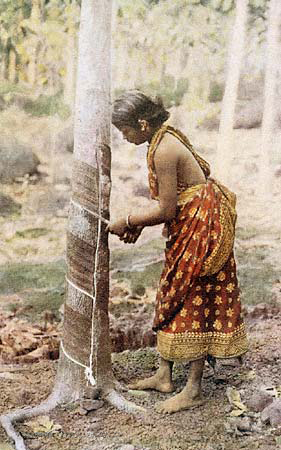
In places such as Kerala and Sri Lanka where coconuts are in abundance, the half shell of coconut was used as the latex collection container. Glazed pottery or aluminium or plastic cups became more common in Kerala and other countries. The cups are supported by a wire that encircles the tree. This wire incorporates a spring so it can stretch as the tree grows. The latex is led into the cup by a galvanised "spout" knocked into the bark. Tapping normally takes place early in the morning, when the internal pressure of the tree is highest. A good tapper can tap a tree every 20 seconds on a standard half-spiral system, and a common daily "task" size is between 450 and 650 trees. Trees are usually tapped on alternate or third days, although many variations in timing, length and number of cuts are used. "Tappers would make a slash in the bark with a small hatchet. These slanting cuts allowed latex to flow from ducts located on the exterior or the inner layer of bark (cambium) of the tree. Since the cambium controls the growth of the tree, growth stops if it is cut. Thus, rubber tapping demanded accuracy, so that the incisions would not be too many given the size of the tree, or too deep, which could stunt its growth or kill it."
It is usual to tap a pannel at least twice, sometimes three times, during the tree's life. The economic life of the tree depends on how well the tapping is carried out, as the critical factor is bark consumption. A standard in Malaysia for alternate daily tapping is 25 cm (vertical) bark consumption per year. The latex-containing tubes in the bark ascend in a spiral to the right. For this reason, tapping cuts usually ascend to the left to cut more tubes.
The trees drip latex for about four hours, stopping as latex coagulates naturally on the tapping cut, thus blocking the latex tubes in the bark. Tappers usually rest and have a meal after finishing their tapping work, then start collecting the liquid "field latex" at about midday.
Field coagula
The four types of field coagula are "cuplump", "treelace", "smallholders' lump" and "earth scrap". Each has significantly different properties. Some trees continue to drip after the collection leading to a small amount of "cup lump" that is collected at the next tapping. The latex that coagulates on the cut is also collected as "tree lace". Tree lace and cup lump together account for 10–20% of the dry rubber produced. Latex that drips onto the ground, "earth scrap", is also collected periodically for processing of low-grade product.
Cup lump
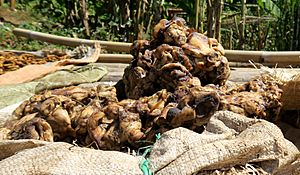
Cup lump is the coagulated material found in the collection cup when the tapper next visits the tree to tap it again. It arises from latex clinging to the walls of the cup after the latex was last poured into the bucket, and from late-dripping latex exuded before the latex-carrying vessels of the tree become blocked. It is of higher purity and of greater value than the other three types.
Tree lace
Tree lace is the coagulum strip that the tapper peels off the previous cut before making a new cut. It usually has higher copper and manganese contents than cup lump. Both copper and manganese are pro-oxidants and can damage the physical properties of the dry rubber.
Smallholders' lump
Smallholders' lump is produced by smallholders who collect rubber from trees far from the nearest factory. Many Indonesian smallholders, who farm paddies in remote areas, tap dispersed trees on their way to work in the paddy fields and collect the latex (or the coagulated latex) on their way home. As it is often impossible to preserve the latex sufficiently to get it to a factory that processes latex in time for it to be used to make high quality products, and as the latex would anyway have coagulated by the time it reached the factory, the smallholder will coagulate it by any means available, in any container available. Some smallholders use small containers, buckets etc., but often the latex is coagulated in holes in the ground, which are usually lined with plastic sheeting. Acidic materials and fermented fruit juices are used to coagulate the latex — a form of assisted biological coagulation. Little care is taken to exclude twigs, leaves, and even bark from the lumps that are formed, which may also include tree lace.
Earth scrap
Earth scrap is material that gathers around the base of the tree. It arises from latex overflowing from the cut and running down the bark, from rain flooding a collection cup containing latex, and from spillage from tappers' buckets during collection. It contains soil and other contaminants, and has variable rubber content, depending on the amount of contaminants. Earth scrap is collected by field workers two or three times a year and may be cleaned in a scrap-washer to recover the rubber, or sold to a contractor who cleans it and recovers the rubber. It is of low quality.
Processing
Latex coagulates in the cups if kept for long and must be collected before this happens. The collected latex, "field latex", is transferred into coagulation tanks for the preparation of dry rubber or transferred into air-tight containers with sieving for ammoniation. Ammoniation preserves the latex in a colloidal state for longer periods of time.
Latex is generally processed into either latex concentrate for manufacture of dipped goods or coagulated under controlled, clean conditions using formic acid. The coagulated latex can then be processed into the higher-grade, technically specified block rubbers such as SVR 3L or SVR CV or used to produce Ribbed Smoke Sheet grades.
Naturally coagulated rubber (cup lump) is used in the manufacture of TSR10 and TSR20 grade rubbers. Processing for these grades is a size reduction and cleaning process to remove contamination and prepare the material for the final stage of drying.
The dried material is then baled and palletized for storage and shipment.
Vulcanized rubber
Natural rubber is often vulcanized - a process by which the rubber is heated and sulfur, peroxide or bisphenol are added to improve resistance and elasticity and to prevent it from perishing. Carbon black is often used as an additive to rubber to improve its strength, especially in vehicle tires, which account for about 70% (~9 million tons) of carbon black production.
Uses
Uncured rubber is used for cements; for adhesive, insulating, and friction tapes; and for crepe rubber used in insulating blankets and footwear. Vulcanized rubber has many more applications. Resistance to abrasion makes softer kinds of rubber valuable for the treads of vehicle tires and conveyor belts, and makes hard rubber valuable for pump housings and piping used in the handling of abrasive sludge.
The flexibility of rubber is appealing in hoses, tires and rollers for devices ranging from domestic clothes wringers to printing presses; its elasticity makes it suitable for various kinds of shock absorbers and for specialized machinery mountings designed to reduce vibration.
Its relative gas impermeability makes it useful in the manufacture of articles such as air hoses, balloons, balls and cushions.
The resistance of rubber to water and to the action of most fluid chemicals has led to its use in rainwear, diving gear, and chemical and medicinal tubing, and as a lining for storage tanks, processing equipment and railroad tank cars.
Because of their electrical resistance, soft rubber goods are used as insulation and for protective gloves, shoes and blankets; hard rubber is used for articles such as telephone housings, parts for radio sets, meters and other electrical instruments.
The coefficient of friction of rubber, which is high on dry surfaces and low on wet surfaces, leads to its use for power-transmission belting and for water-lubricated bearings in deep-well pumps. Indian rubber balls or lacrosse balls are made of rubber.
Around 25 million tonnes of rubber are produced each year, of which 30 percent is natural. The remainder is synthetic rubber derived from petrochemical sources. The top end of latex production results in latex products such as surgeons' gloves, balloons and other relatively high-value products. The mid-range which comes from the technically specified natural rubber materials ends up largely in tires but also in conveyor belts, marine products, windshield wipers and miscellaneous goods. Natural rubber offers good elasticity, while synthetic materials tend to offer better resistance to environmental factors such as oils, temperature, chemicals and ultraviolet light. "Cured rubber" is rubber that has been compounded and subjected to the vulcanisation process to create cross-links within the rubber matrix.
Images for kids



